Executive Roundtable: Decarbonization goals, the role of hydrogen and the aftermath of COVID
13 September 2022
Diesel & Gas Turbine Worldwide asked officials at key companies within the large engine and turbine industries to weigh in on a series of questions intended to provide a high-level view of the conditions, challenges and opportunities they see in the marketplace.
The magazine would like to thank Bernhard Zemann, senior vice president and head of Hoerbiger Engine Technology; Håkan Agnevall, president and CEO, Wärtsilä Corp.; Karim Amin, member of the Executive Board of Siemens Energy AG; and Uwe Lauber, chief executive officer of MAN Energy Solutions SE.
Q: How is your company positioning itself with regards to decarbonization?
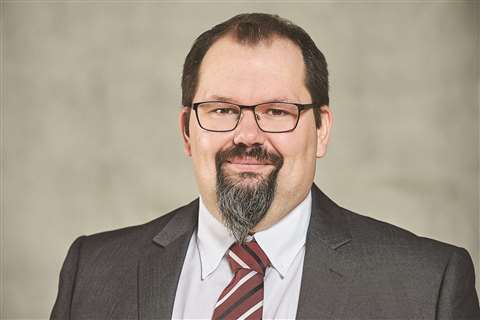 Bernhard Zemann, senior vice president and head of Hoerbiger Engine Technology
Bernhard Zemann, senior vice president and head of Hoerbiger Engine Technology
Zemann: Decarbonization is an absolute priority for us. We’re coming from the oil and gas business, and for us it is essential to position ourselves on the way towards decarbonization using our 125 years of experience. We’ve analyzed and evaluated where we could bring in our effort for the decarbonization path that was clearly identified with full steam ahead on hydrogen. Because we are a gas specialist, right, we are dealing with gas for 125 years – and hydrogen is a gas just with a little bit more complexity, I would say.
Agnevall: Wärtsilä has significant value creation potential as a pioneer and technology leader in the decarbonization transformation. Driven by our purpose of enabling sustainable societies through innovation in technology and services, we are committed to support our customers on their decarbonization journey, thereby shaping a sustainable future for the marine and energy sectors we operate in.
We are leading the way in enabling 100% renewable energy systems around the world. To optimize power systems, we produce power system modeling to map the path to decarbonizations in regions, cities and countries around the world and then deliver the technology needed to accelerate the deployment of renewable energy. We are in the top three energy storage providers globally (BNEF, 2021), and deliver grid balancing engines capable of running on sustainable fuels to enable intermittent renewables to power our energy systems 24 hours a day, seven days a week.
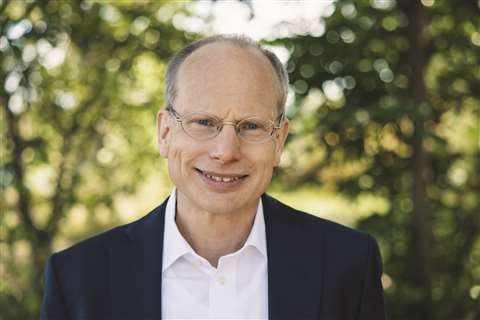 Håkan Agnevall, president and CEO, Wärtsilä Corp.
Håkan Agnevall, president and CEO, Wärtsilä Corp.
We believe that decarbonizing the marine sector requires a wide range of different measures. We have solutions for the decarbonization of the powertrains, energy efficiency and energy savings as well as for optimization of the whole logistic chain. Additionally, through our services we can maximize system utilization to ensure the highest level of efficiency. Also, meeting the industry’s sustainability goals and the pathway to decarbonization is intrinsically linked with digitalization; progress cannot be made on either without the other moving forward in tandem.
As to Wärtsilä’s own actions with regards to decarbonization, our goal is by 2030 to become carbon neutral in our own operations and to provide a product portfolio which will be ready for zero-carbon fuels. These ambitious “Set for 30” decarbonization targets demonstrate our commitment to our purpose.
Amin: Siemens Energy is a leading force in the global energy transition. With our portfolio that covers the entire energy value chain, our capabilities and our track record, we’re supporting our customers in their transition to more sustainable energy systems.
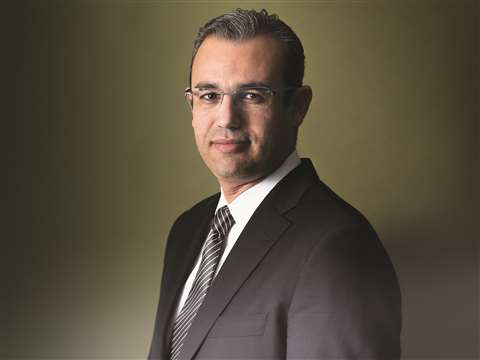 Karim Amin, member of the Executive Board of Siemens Energy AG
Karim Amin, member of the Executive Board of Siemens Energy AG
Through our majority stake in Siemens Gamesa, we have over 100 GW of installed capacity in off- and onshore wind power, and we see accelerated and exponential growth in new wind projects across the globe. What’s more, all of this renewable energy needs to be transmitted to where it’s consumed or stored. As one of the world’s leading grid technology companies and with our HVDC systems, we’re bringing offshore wind power to consumers and connecting countries and entire continents. Our electrolyzer portfolio is taking storage – a crucial building block in the energy transition – to the next level. By pioneering the production of green hydrogen, we’re enabling the decarbonization of entire sectors, including buildings (heating and cooling), transportation and industry.
Our capabilities extend even further. Our gas-fired power plants aren’t just critical to maintaining the stability of energy systems that are increasingly based on renewables: We’re also advancing low- and zero-emissions power generation by making our gas turbines more efficient and hydrogen ready. Green hydrogen, which is produced from renewable energy and stored, can be used in our gas turbines as a sustainable fuel to replace natural gas. We’re currently able to co-fire up to 75% hydrogen, and the plan is to reach 100% by 2030. Once in operation in 2025, the Stockholm Exergi site will be one of the first gas turbine plants with an SGT-800 running on 100% green liquid fuel.
Another important dimension of the energy transition is the decarbonization of the industrial sector. We’re helping our industrial customers decarbonize their operations by electrifying their heat requirements, optimizing their energy consumption and/or introducing green hydrogen efficiently and at scale in their processes.
Lauber: Decarbonization is at the core of our future strategy, which I can sum up in one sentence: “Moving big things to Zero.” That is our mission. Some of the industries we serve, e.g., the shipping industry or energy generation, are key sectors that keep the global economy functioning. At the same time, they offer a very substantial lever to bring down GHG emissions. As you know, shipping alone accounts for almost 3% of global CO2 emissions.
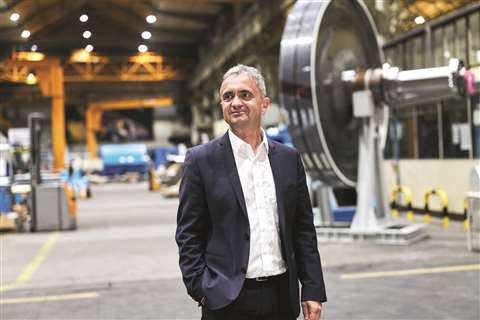 Uwe Lauber, chief executive officer of MAN Energy Solutions SE
Uwe Lauber, chief executive officer of MAN Energy Solutions SE
To use that lever, we need to decarbonize shipping via the fuel. Large ocean-going vessels cannot be electrified with batteries or fuel cells, which is why we are convinced that large combustion engines will continue to power long-distance ships – and also power plants – in the future. However, they will initially use less CO2-intensive fuels like LNG, LPG and ethane, and increasingly alternative, sustainable fuels like green ammonia, methanol and synthetic methane.
All of these future fuels need hydrogen as a feedstock, some of them also CO2. We are therefore investing €500 million to ramp up our electrolysis business, which runs under the name of ‘H-Tec Systems’. Also, we are developing solutions to capture CO2 from industrial processes in a new CCU/S business segment.
In particular, green hydrogen and synthetic fuels derived from renewable energy using power-to-X technology will achieve net zero. Experts see hydrogen and power-to-X as key technologies in the march towards decarbonization and predict massive cost efficiencies once facilities are established on an industrial scale.
Q: There’s a lot of discussion around the future of hydrogen. What are your thoughts and how big a role will it play in your markets?
Agnevall: Hydrogen and other sustainable fuels will be essential in not just decarbonizing energy, but also marine, industry, heating and more. To achieve the final push to 100% renewable energy systems and decarbonized shipping, sustainable fuels need to be available and affordable, and we must have engines capable of using them.
Wärtsilä has launched a major test program toward carbon-free solutions with hydrogen and ammonia fuels. Our engines can already now run on a fuel mix comprising 25% hydrogen. We have tested engines with a blend of up to 60% hydrogen and 40% natural gas and are continuing development toward a pure hydrogen engine.
For the energy market, Wärtsilä expects to have an engine and plant concept for pure hydrogen operation ready by 2025. It is anticipated that green hydrogen will deliver 7% of the global energy demand by 2050. In the energy industry, hydrogen will be one of the major pathways forward, but the whole ecosystem around hydrogen is still in an early stage. It is unlikely that marine applications will widely shift to hydrogen in deep-sea shipping due to its low energy density and complex storage. For both marine and energy, the transition to green fuels will be gradual – first blending the new fuels with existing fuels, and increasing the share of green fuels over time as they become readily available at affordable price. Fuel flexibility and fuel efficiency will be key going forward.
Zemann: As I said it’s essential; it’s absolutely a priority also within Hoerbiger’s board of directors. We have six different business areas, six different divisions, and all of them are now going forward and concentrating on hydrogen. So, we’re looking at how each division can create value on the hydrogen path.
If you look at our business, we cover solutions from upstream all the way to downstream applications in the hydrogen value chain. We make compression and fueling of hydrogen possible, hence, we enable its transportation until it reaches the end customers. Here again, Hoerbiger provides key technologies for fuel cells and hydrogen internal combustion engines. Summarizing, one can say that it’s really a string of pearls when you look at Hoerbiger and see how all divisions put together the effort towards hydrogen.
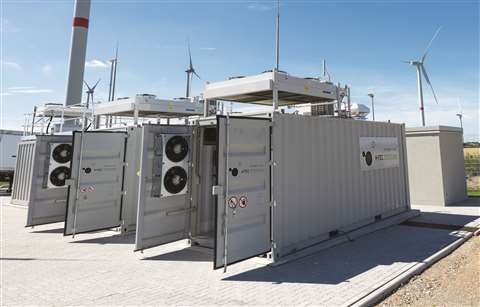 Over the next few years, MAN Energy Solutions will invest up to €500 million in its subsidiary H-Tec Systems to transform the hydrogen specialist into a mass producer of PEM electrolyzers as quickly as possible. (Photo: MAN Energy Solutions)
Over the next few years, MAN Energy Solutions will invest up to €500 million in its subsidiary H-Tec Systems to transform the hydrogen specialist into a mass producer of PEM electrolyzers as quickly as possible. (Photo: MAN Energy Solutions)
Lauber: MAN Energy Solutions announced an investment of up to €500 million in hydrogen production in March 2022 with the aim of pushing our subsidiary, hydrogen specialist H-TEC SYSTEMS, into a market-leading position as a mass producer of PEM electrolyzers.
Over the next five to 10 years, green hydrogen will become one of the most important primary energy sources for the global economy as it continues to decarbonize. With PEM electrolysis, H-TEC SYSTEMS has mastered one of the most important processes for industrially scaled hydrogen production from renewable energy sources. The technology is mature and has already been placed on the market successfully. The next step is therefore to scale and set up highly automated serial production, and we would like to make rapid progress with this.
Amin: In many parts of the world, the hydrogen economy has indeed become one of the foremost strategies for transforming energy systems. This is especially understandable in the context of the war in Ukraine and the resulting changes in fossil fuel supply chains. The energy sector and industry are both increasingly looking for alternatives. The crucial role of hydrogen lies in its use as a storage medium. When a lot of electricity is generated with renewable energies, or when electricity consumption is low, green hydrogen can be produced. It can then be burned as an admixture or as pure hydrogen in gas turbines.
Along with our partners, we’re working on a wide variety of concepts and pilot projects to integrate hydrogen electrolyzers in power plants, chemical plants and even heating systems. One example is our LiquidWind project in Sweden, where we’ll produce 50000 tons of e-methanol per year, reducing CO2 emissions by about 100000 tons in the same period. Another example is our Haru Oni project in Chile. Haru Oni will be the first commercial power-to-X facility. Once in operation, it will produce e-fuels using renewable energy. This will contribute to decarbonizing transportation by roughly 90% compared with transportation that uses fossil fuels.
More recently, we announced the creation of a joint venture with Air Liquide. Our collaboration will be dedicated to the series production of industrial-scale renewable hydrogen electrolyzers in Europe. Production is expected to begin in the second half of 2023 and ramp up to an annual production capacity of 3 GW by 2025. (Air Liquide will take 25.1%, and Siemens Energy will hold 74.9% of the joint venture, whose creation remains subject to approval of the responsible authorities).
Having said that, we don’t see green hydrogen in a position to fully replace natural gas at this point in time – neither in terms of scale nor cost. Several countries in the European Union and numerous states in the U.S., however, have already launched ambitious programs. These programs promote the use of green hydrogen by creating conditions that increase its scale to the industry level. All players involved need to significantly accelerate the pace of hydrogen projects in terms of both development and implementation. We need far-reaching investments in infrastructure to make hydrogen available on a larger scale (rather than just coupling production and consumption directly on site). With our H2-ready gas turbines, we’re laying the groundwork for the future large-scale use of hydrogen.
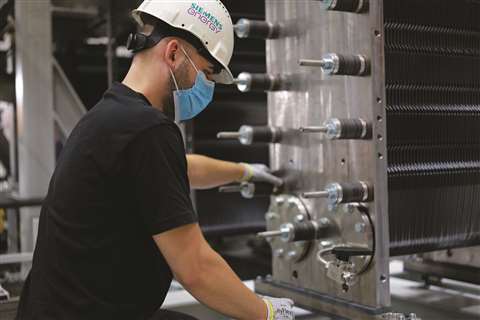 Siemens Energy and Air Liquide announce the creation of a joint venture dedicated to the series production of industrial scale renewable hydrogen electrolyzers in Europe. (Photo: Siemens Energy)
Siemens Energy and Air Liquide announce the creation of a joint venture dedicated to the series production of industrial scale renewable hydrogen electrolyzers in Europe. (Photo: Siemens Energy)
Q: What do you consider to be the key emerging trends in in your markets and how is your business addressing them?
Zemann: Now, talking about my division, Engine Technology, we’re the expert for large industrial engines, gas engines, either for driving compressors for the upstream segment or downstream going into power generation, but also mid- to heavy-duty mobility. Here, we are the specialists on the valves injecting the gas for combustion. And for us, it is very clear that when the market moves to hydrogen, we can support this path.
As for my division, we have really gone full steam ahead on embracing innovation. When you look at our innovation roadmap, all of our concentration is focused on hydrogen. That means, we are not really doing anything on innovation for typical gas valves – meaning natural gas, CNG, LNG, whatever. We really completely shifted our focus to hydrogen, which now makes up 90% of our innovation roadmap. That is a very clear message.
Amin: There are different scenarios for the future development of the energy sector. All of them, however, predict that:
- Electricity production worldwide will grow faster than GDP. Likewise, the share of electricity in the energy balance will also grow.
- Production capacity will grow even faster. For example, if you want to replace 1 MW of coal-fired power, you need 2 to 3 MW of renewable capacity due to the lower runtime of renewables.
- Grid investments will grow to unprecedented levels, not just for new connections but also for the upgrading and renewing of existing grids. In the U.S. alone, there will be as much investment in the coming decade as over the past 150 years.
- Coal will be phased out, of course, and a large proportion of newly installed capacity will come from renewables. Gas turbines, however, will still play a vital role, at least for a while in order to ensure the security of supply. Moving forward, they can be fired on 100% hydrogen.
- And last but not least, energy efficiency will become a competitive criterion for industrial customers. Take Europe as an example. Due to recent geopolitical developments, European installations will face rising energy costs while competing with peers in other regions where energy costs are substantially lower.
To master these challenges, we’re implementing a new operating model in our company that will increase customer focus, speed, transparency and accountability. And we’ll organize ourselves around one very dominant objective: to be “The World’s Most Valued Integrated Energy Technology Company.” Everything we do will serve this purpose. Our customers, for example, will be able to work with regional hubs that cover our complete portfolio of gas turbines, grid technologies and the transformation of industries. We’ll have one project execution team for large EPC projects that can leverage all our knowledge in HVDC and combined cycle power plants. This will allow our customers to access an expert team to execute cutting-edge projects. In addition, we’ll have five innovation centers across the globe in order to benefit from strong collaborations with external partners. These are just a few key elements of our new model.
Agnevall: Long-duration energy storage / power-to-X is one of the exciting developments that we expect to see over the coming years as it can decarbonize industries, transportation and the energy sector while utilizing existing infrastructure. At Wärtsilä, we will be at the vanguard of that transition, as we deploy future-proof engines around the world which are capable of running on sustainable fuels.
Also, in maritime, the future will evolve much around future fuels such as ammonia and methanol. But because it is difficult to predict which fuel will be dominant in the future, we want to be fuel agnostic and continue developing engines that run on different fuels. For example, earlier this year we launched the Wärtsilä 23 methanol engine. But the maritime future is not just about fuels, it is also about the next steps in abatement technologies and increase in hybrid and battery systems and development of energy-saving devices. Our strong focus on efficiency and utilizing connectivity and data will also continue going forward.
We also believe that partnerships and collaboration will become an even more common way of working in our industries in the future. Climate change is one of the biggest challenges of our time, and through active engagement in ecosystems and collaboration we can ensure a broad solution offering to our customers.
Q: As a COVID pandemic continues to disrupt supply chains, how has your company adapted?
Agnevall: Our team continues to engage with our supply chain partners to secure the business continuity. We can see cost inflation in the supply chain, as well as for transportation cost and for fuels. Compared to the beginning of the pandemic, we have more uncertainty in the supply chain overall related to both material shortage and transportation. We are mitigating these risks by maintaining close relations with suppliers, renegotiating some contracts and by having more buffers in supply and transportation.
Zemann: That’s a good point and there we have a big advantage because, as the Hoerbiger Group is being managed by a foundation, we do not depend on shareholders – we do not think about quarterly results but about long-term success. Hence, we could very quickly “de-adapt” from a just-in-time mindset and switch to having more stock on hand, which was more or less demonized over the past 20 years. We always talk about 10 and 15 years into the future, which is normally not what happens in shareholder companies. That really is what enabled us to quickly adapt to the pandemic and changing supply chains.
It was a stress test which Hoerbiger passed successfully and quickly showed results. We heard from our customers, our OEMs, that we were one of the few suppliers which was able to keep the supply intact. After some emotional talking, we were told that we were the only ones who could deal with this. All the others had really big supply chain challenges; and I won’t say we didn’t have challenges, but we could handle it because we, ironically, “just in time” adapted our stock policy. The implementation was not a long process – we did not spend a lot of time on calculations and business cases discussing up and down, left and right, you know. We just made the orders. And that helped us tremendously through the pandemic, especially through 2021. We were fully flying through this year having the stock on hand.
Amin: We’re all noticing how complex and fragile the global economic system and supply chains have become. The pandemic and the war in Ukraine have had a severe impact – not just on prices but also on the availability and delivery time of components and raw materials. Even more so than in the past, dedicated planning processes, global supplier management and exchanges between our sites and warehouses are prerequisites for meeting these challenges.
As a result of the pandemic’s impacts, we’ve intensified our supply chain risk and resilience management by implementing regular monitoring of 3000 of our key suppliers. Putting in place early warning indicators and tracking has been of great value since the war in Ukraine began. Also, gas and power and SGRE have joined forces in negotiations, with a resulting 50% price reduction per ton compared with the spot market. We’re securing inventory for our suppliers by supporting them in obtaining priority shipments. We’ve bundled renegotiations with sea freight carriers and achieved rate cuts of roughly 50%. And we’ve bundled shipping to simplify and secure logistic chains – from Shanghai to Hamburg, for example.
Another way that Siemens Energy is addressing potential supply chain delays is through the increased use of additive manufacturing. This technology has already been used for several years to accelerate R&D projects, replace legacy parts, increase performance and print performance components. We’re now exploring new areas of application. The decentralized manufacture of tools and parts, including producing and repairing components at our customers’ premises, creates significant time savings. In addition, it increases our independence from entrenched supply chains.
Q: With all the enormous challenges in the last few years – COVID, supply chain disruptions, a war in Europe – how do you try to continue business as usual?
Zemann: Right now, we are placing orders with the delivery time of 12 to 15 months. And sometimes we even do this without having the full “go ahead” from a contractor. So, we really take these risks on our shoulders, and this is something that we can do and that we need to do from our point of view.
It’s certainly not business as usual. It’s a mindset change to prepare for severe times – I would call it severe times because nobody knows how it will go and in what direction it will develop. We are not preparing for business as usual. We are thinking of it as an impact, that it was an impact and that it will stay an impact for who knows how long. And for this, we are already prepared in order to be able to supply our partners and customers also through these difficult times
Amin: The last two to three years have proven that “business as usual” has to be understood in a new way. At Siemens Energy, we like to say that “We have to be weatherproof.” There will always be headwinds coming our way, they’ll just have different names.
Our operating model takes this into consideration. And with our Commodity Ecosystem Strategy, we’re turning insight into foresight. We’re taking a leading role in designing ecosystems to decrease costs and increase our adaptability. We collect comprehensive knowledge about business and customer needs as well as supply markets, and we’re selecting and developing the best suppliers from across the globe. In other words, our goal is a balanced footprint that maximizes opportunities and minimizes risks.
Agnevall: As always, ensuring the health, safety and well-being of our employees is our highest priority. After that, we aim at delivering the best possible support to our customers. Our recently launched strategic framework, which we call the Wärtsilä Way, gives the direction for our company – how we are shaping the decarbonization of the marine and energy industries while leveraging market recovery and growth. To support this, we actively follow what is happening in the markets and continuously re-assess how to stay competitive.
Also, more than half of our revenues come from services today, and this naturally brings stability to our business. The utilization of our installed equipment is increasing after the pandemic. Going forward, data, connectivity and digital solutions will have a more central role in our operations, enabling long-term performance-based agreements with the customers. Taking such a partnership approach helps us support our customers effectively over the life cycle and moves Wärtsilä up in the service value ladder.
Q: Given the challenges mentioned, are you optimistic about your markets?
Zemann: Absolutely. We made the decision to go for hydrogen and make it the center of our innovation roadmap, and we made this very early. This is paying off now. It was in 2018 when we decided to fully focus on hydrogen for internal combustion engines. This was about 15 years after we had already developed and brought to market the first hydrogen injector to be applied in a passenger car’s ICE. However, four or five years ago all talks related to hydrogen were connected to fuel cells. But we were early and said: “No, it’s not just about fuel cells – you can also use hydrogen for combustion engines”. And we see many applications which confirm our view.
However, it was a challenge to convince people internally, especially for me. Talking about an innovation roadmap related to technologies for internal combustion engines, which many see to become extinct in the future, was not an easy task. But luckily, it quickly turned out that this was the right move. And all this is why we were able already in 2019 to have the first injectors ready with an acceptable lifespan. We went rapidly from concept prototypes to sample prototypes – and quickly our first partners and OEMs followed. And then it really went wild because by 2019 the European Commission finally established the hydrogen ICE as a zero-emission technology. So, politically and legally, it is a zero-emission drive equal to EVs and fuel cells. And that completely breaks down the door.
Finally, if you ask me how I see the market, I will say very promising because of our early move into hydrogen.
Amin: Yes, I am. Over the next few decades, there will be substantial investments in the electricity and energy markets to make “net zero” a reality, all while maintaining security of supply and affordability.
We estimate that by 2030, investments in power generation will amount to more than €780 billion, which is equivalent to 3300 to 5300 additional GW, mainly coming from renewable energy and also gas turbine projects. €420 billion will be invested in transmission and distribution projects, with €100 to €240 billion just for interconnectivity projects. Investments in large hydrogen projects and the decarbonization of industries will grow exponentially.
Siemens Energy will be able to profit from these planned investments on the energy generation side, transmission and storage, and the consumption side. As the only energy company that can provide an integrated solution and manage fluctuations in these investment cycles, we’re in a unique position.
Agnevall: The urgency of the climate challenge is building. We are seeing more frequent extreme weather events and we need to deliver the solutions today to protect tomorrow.
At Wärtsilä, we are providing essential technology to enable the world to decarbonize and these solutions will become increasingly important as we move towards renewables and flexibility.
I’m an optimist, both about our role in the market and humanity’s ability to meet the climate challenge. I believe we will succeed but it will require more change over the next 10 years than we have seen in the past 30 years.
Our analysis has shown that the potential environmental, economic and societal benefits of the energy transition are considerable, but time is of the essence. Policymakers, regulators and industry must come together to have honest discussions, ask the right questions and think strategically to ensure the correct policy and regulatory frameworks are put in place. The same applies to the marine market – maritime will transform with an unprecedented speed. The regulatory frameworks and policies are accelerating the decarbonization of shipping. There is an increasing demand for green transport, driven by companies’ environmental commitments to their customers and investors’ push for sustainability targets.
Q: Both short and long term, what keeps you up at night?
Zemann: What concerns me the most? I mean, we all know that the political and legislative future on hydrogen is not set. It is uncertain whether it will really go down this way. You never know what the next big event will be, especially in current times. First, it was the pandemic, now it’s the war. And next we are drifting into an energy crisis, there’s no doubt about it. This might slow down the transition towards hydrogen, or even shift it to a completely different direction. But I think this to be very unlikely. What I see now is that the energy crisis is actually supporting and accelerating our way towards hydrogen.
But I will say that it’s like from the film Forrest Gump: “Life is like a box of chocolates; you never know what you’re going to get.”
Amin: Speed – the fight against climate change needs to speed up. We need to move fast on policies, regulations and technology. We must strengthen our political will.
Stability – energy systems need to be stable regardless of weather conditions, time of day or price shocks. In the absence of a stable electricity supply and its associated cost, our communities can’t develop and prosper.
Societal awareness – it’s very important that our societies understand the balance between speed and stability. I often feel that this awareness is underdeveloped, even completely absent, in some of the global debates on the energy transition. We don’t have a Planet B. We have to get this right, and we need to be fast without losing our stability. That’s what keeps me up at night.
Lauber: MAN Energy Solutions is busy developing its existing portfolio, especially within its regular business, by pushing the trend towards driving enormous ship engines with alternative, greener fuel (and ultimately green, synthetic fuel instead of diesel fuel). But is also targeting growth in the form of two new business areas.
The first involves the construction of hydrogen factories, electrolyzers, where you transform clean electricity from wind and solar energy into green hydrogen, which will ultimately replace natural gas and coal within industry.
The second is the catching of carbon dioxide so it does not rise into the atmosphere and drive climate change, such as with coal-, gas- or oil-burning power plants. While energy production can reduce CO2 emissions by introducing more wind turbines or solar fields, replacing existing energy sources in processes such as the manufacture of cement, glass and steel that emit masses of CO2 is more difficult.
We view CO2 as not just a waste product but also a product in itself that can be liquefied and brought by tanker to the next consumer, for example, as a raw material for the production of fertilizer, plastics or synthetic fuels. In southern Norway, there is a cement works where, from 2023, CO2 arising from production will be captured. MAN is supplying the powerful compressors that will help capture about 500000 tons of CO2 annually.
In respect to the current high levels of inflation gripping the market, MAN Energy Solutions does not view this currently as a major threat to its goals due to the flexible nature of the contracts we typically enter, which allow for price fluctuations.
Agnevall: Generally, I sleep very well! Transforming a business is one of the most rewarding things that you can do in life – bringing a team together to create real change within an organization and wider society. That’s why I bring focus on continuous improvement. It is a leadership principle that involves everybody working a little bit smarter every day. That develops your competitiveness and eventually helps serve your customer in a better way.
Longer term, I am deeply concerned about our response to the climate crisis. The global community is moving too slow to reach the Paris treaty targets. We need to change the way we operate, and further collaborate towards stopping global warming.
However, I am optimistic about our future because I believe in human beings. When confronted with the harsh reality of the planetary boundaries, I am certain that we’ll get our act together.
This article originally appeared in the July-September 2022 issue of Diesel & Gas Turbine Worldwide.
STAY CONNECTED




Receive the information you need when you need it through our world-leading magazines, newsletters and daily briefings.
POWER SOURCING GUIDE
The trusted reference and buyer’s guide for 83 years
The original “desktop search engine,” guiding nearly 10,000 users in more than 90 countries it is the primary reference for specifications and details on all the components that go into engine systems.
Visit Now
CONNECT WITH THE TEAM










